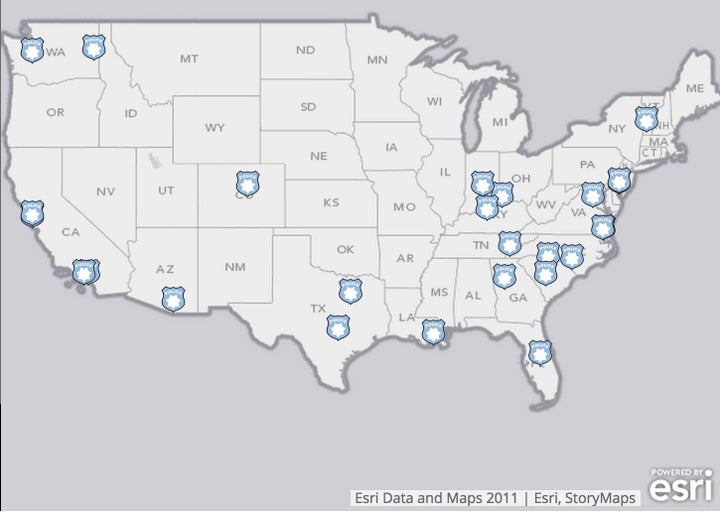We entrust police officers with the ability to use deadly force when necessary to uphold their oaths to protect and serve the public. In many states and cities, however, the public still doesn't know just how many times a year the cops apply deadly force, or to whom. The federal government, concerned citizens and multiple media organizations are working to bring transparency to this issue. In some cases, they're even working together.
In addition to databases at Deadspin, Gun Violence Archive and FatalEncounters.org, The Washington Post is compiling a list of every fatal shooting by a police officer in the line of duty. A list like that, however, would not include Eric Garner and Freddie Gray, both of whom died during their interactions with police without a single shot being fired. The Guardian has gone one step further than the Post, tracking all people killed by police in the United States by any means, as has the Killed by Police Facebook page. These efforts, as you might expect, are registering a much higher count of police killings than the ones that focus only on shooting deaths. Critics argue, however, that by including traffic incidents and similar accidents in the overall tally, it misleads the public and robs the data of context.
In 2000, Congress required federal law enforcement agencies to report to the Department of Justice the number of people who die during an arrest or in custody. As Mother Jones has reported, Congress has passed other laws requiring the DOJ to track the use of excessive force by U.S. police officers, but consistent, quality data collection is still not happening.
Last month, the DOJ released a new tranche of data from more than 3,000 state and local law enforcement agencies. But a New York Times investigation found this data to be virtually useless for analysis. While almost all police departments track shootings, there's great variation in how closely departments record the use of other types of force -- if they even record it at all. And historically, that information has rarely been published online for the public to see.
As Times reporters Sarah Cohen and Matt Apuzzo observed, this state of play represents a significant challenge for the White House's Police Data Initiative, which launched in May.
President Barack Obama can call for more and better data on the use of force by police officers, but the White House has no authority by which it can make local jurisdictions track or disclose this information.
That's unfortunate, since there's a lot that the public and civil rights investigators could learn from analyses of that data, as Cohen and Apuzzo reported:
When the Justice Department’s civil rights investigators have scrutinized police departments and reviewed records that would not otherwise have been made public, they have found evidence of abuse.
In Seattle, investigators reviewed the Police Department’s reports on the use of force and found that one out of every five episodes was excessive. In Albuquerque, investigators concluded that most police shootings from 2009 to 2012 were unjustified. Such conclusions have been amplified by videos of deadly police interactions in Cincinnati and North Charleston, S.C., as well as on Staten Island, and elsewhere.
But those investigations focus only on departments suspected of unconstitutional behavior. And police officers say the videos do not reflect the tens of millions of interactions that officers and civilians have each year. Federal estimates have concluded with “substantial confidence” that, when considered as a percentage of that overall number, officers use force very rarely.
The Obama administration is trying to enhance police training and improve relationships between officers and minorities. But without better data, it will be hard to know if those efforts are working -- or even if use of force was objectively a problem in the first place.
This week, six months into his tenure as the country's chief data officer, DJ Patil released a memo explaining how the federal government has been using data to benefit the public. I asked Patil about the initiative in May at the International Open Data Conference in Ottawa -- specifically, about what kinds of law enforcement data should and shouldn't be open, and to whom, and why. My question comes at about 30:30 in the video below.
"When we say use of force, and we start opening up the data... [it opens up] all sorts of questions, like for example de-anonymization, or can we anonymize, even, the data," said Patil. "And it's not clear that any form of anonymization will hold up over long historical trends, the way computing is going."
He continued:
"I think the most succinct answer is 'I don't know the answer to that.' The only way we are going to get to an answer on that is through direct engagement, and part of that is by bringing the right set of people around the table together. That includes the police chiefs, that includes the mayors, that includes the community organizers, that includes the different representatives for different groups in that community, and figuring out what's right."
To put it another way, the Police Data Initiative is an opportunity for the White House to encourage the country's police departments (if not actually compel them) to share more data with the public. By doing so, it gives police departments a chance to respond to public demand for better insight into the interactions between law enforcement officers and communities they are sworn to protect and serve.
Historically, police departments haven't shared that data, but public pressure is bringing many of them to the table. The Police Data Initiative isn't a substitute for systemic criminal justice reform, but if it's successful, it will reveal areas that are in need of attention, and perhaps better illustrate the way that multiple approaches to policing are better at building public trust and reducing crime than using an across-the-board, one-size-fits-all strategy.

When the initiative launched in May, 21 departments across the United States were involved. They've each committed to releasing at least three data sets on police-citizen interaction -- although there's no timeline for when those releases are supposed to happen.
According to a White House spokesperson, 17 data sets have been released to date at the Police Foundation's Public Safety Open Data Portal. They include data on officer-involved shootings, calls for service, vehicle citations, assaults on officers and citizen complaints. So far, the Dallas Police Department is the only one in the country that's posted its data on officer-involved shootings at this portal.
The White House says 13 police departments are currently working toward releasing use-of-force data sets. These data sets will be released at the local level, however -- primarily through city open data portals. For instance, the Philadelphia Police Department is sharing crime data and statistics on its own site.
"What we're going to find is that it's going to vary a fair amount from each state to state," Patil said in May. "The powerful thing, especially for those of you that are in places where you may be trying to think about this across a large landscape -- you say, well, Group One is doing it one way, Group Two is doing it another way. How do we figure this out? Embrace that, that they're doing it different ways."
"That's an experiment," he went on. "It's an experiment that you get to see and iterate, but know that you're going to iterate very quickly to a right answer. The idea here is to say -- great, Camden, New Jersey, you're doing it this way. Oakland, California, you guys are doing it this way. What can we actually learn for what is the better solution?"
In the meantime, the White House is moving forward with the Police Data Initiative, with 24 police departments participating in weekly calls. They're developing a community of practice around open data, sharing insights about how to get data out of records management systems and working with external partners like Code for America and the Police Foundation to jump-start data sharing.
Police departments are also developing best practices for making their data sets available, like releasing early versions through trusted partners to help with cleanup and refinement. Presidential Innovation Fellows like Denice Ross are hoping to build trust through data, using data sets as a form of community engagement -- helping to make government activity accessible to ordinary people in New Orleans and beyond, and creating new venues for feedback on how people actually experience city services. You can hear an update on the initiative from Ross and Clarence Wardell, another fellow, in the clip below.
But open police data, by itself, will never be enough to bring about widespread social change. External accountability mechanisms, like the media, courts, councils and legislatures, will need to react to what the data actually shows.
Standards and incentives are both genuine issues here, as shown by the Times investigation. Unfortunately, it's not hard to imagine why a police department might want to edit or distort data about how it uses force, or even suppress it altogether -- especially if the data shows patterns of bias based on race or income.
As David Simon, creator of HBO's "The Wire" and a former Baltimore Sun reporter, told the journalist Bill Keller earlier this year, "juking the stats" is a demonstrable risk if political pressure is high and accountability is lacking.
[Baltimore police] cooked their own books in remarkable ways. Guns disappeared from reports and armed robberies became larcenies. Deadly weapons were omitted from reports and aggravated assaults became common assaults. The Baltimore Sun did a fine job looking into the dramatic drop in rapes in the city. Turned out that regardless of how insistent the victims were that they had been raped, the incidents were being quietly unfounded. That tip of the iceberg was reported, but the rest of it, no. And yet there were many veteran commanders and supervisors who were disgusted, who would privately complain about what was happening. If you weren’t a journalist obliged to quote sources and instead, say, someone writing a fictional television drama, they’d share a beer and let you fill cocktail napkins with all the ways in which felonies disappeared in those years.
I mean, think about it. How does the homicide rate decline by 15 percent, while the agg assault rate falls by more than double that rate. Are all of Baltimore’s felons going to gun ranges in the county? Are they becoming better shots? Have the mortality rates for serious assault victims in Baltimore, Maryland suddenly doubled? Did they suddenly close the Hopkins and University emergency rooms and return trauma care to the dark ages? It makes no sense statistically until you realize that you can’t hide a murder, but you can make an attempted murder disappear in a heartbeat, no problem.
In sum, it will be critical for the public to be involved in pushing for data release, and vital for researchers, advocates and the media to continue to check those numbers once the data spigots open.
